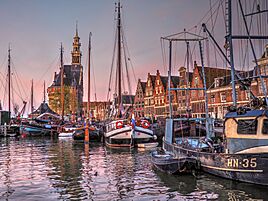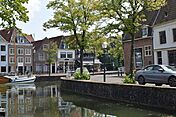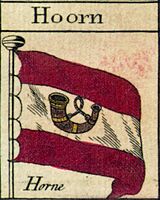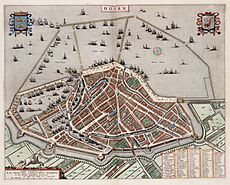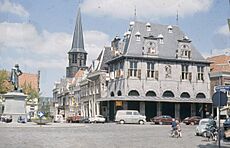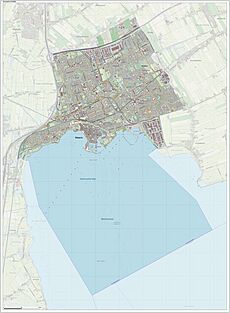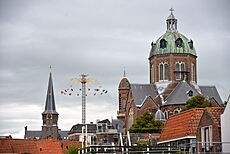Hoorn facts for kids
Quick facts for kids
Hoorn
|
|||
|---|---|---|---|
|
City and municipality
|
|||
|
|
|||
|
|||
Nickname(s):
|
|||

Location within North Holland, Netherlands
|
|||
| Country | Netherlands | ||
| Province | North Holland | ||
| Subregion | West Friesland | ||
| City rights | 1357 (668 years ago) | ||
| Government | |||
| • Body | Municipal council | ||
| Area | |||
| • Total | 53.46 km2 (20.64 sq mi) | ||
| • Land | 20.38 km2 (7.87 sq mi) | ||
| • Water | 33.08 km2 (12.77 sq mi) | ||
| Elevation | −1 m (−3.3 ft) | ||
| Population
(1 January 2021)
|
|||
| • Total | 73,619 | ||
| • Density | 3,613/km2 (9,360/sq mi) | ||
| Demonym(s) | Hoornaar or Horinees | ||
| Time zone | UTC+1 (CET) | ||
| • Summer (DST) | UTC+2 (CEST) | ||
| Postal codes |
1620–1628, 1689, 1695
|
||
| Area code | 0229 | ||
Hoorn is a historic city and a municipality in the northwest of the Netherlands. It is located in the province of North Holland. Hoorn is the biggest town and the main city of the West Friesland area.
The city sits on the Markermeer lake. It is about 20 kilometers (12 miles) east of Alkmaar and 35 kilometers (22 miles) north of Amsterdam. Hoorn has over 73,000 people living there. Its land area is about 20.38 square kilometers (7.87 square miles). This makes it one of the most crowded municipalities in North Holland. Besides the city of Hoorn, the municipality also includes the villages of Blokker and Zwaag. It also has parts of the small settlements called De Hulk and Munnickaij.
Hoorn is famous in the Netherlands for its rich past. The town became an official city in 1357. It grew very quickly during the Dutch Golden Age. This was a time when the Netherlands was very rich and powerful. Hoorn became a busy port city and was home to one of the main offices of the Dutch East India Company (VOC). This was a huge trading company.
Later, in the late 1700s, Hoorn found it hard to compete with nearby Amsterdam. It stopped being a major port city. Instead, it became a local trading center for the smaller villages around West Friesland. Today, Hoorn has modern neighborhoods and a beautiful old city center. Because it's close to Amsterdam, some people see it as part of the larger Randstad area. Two famous places, Cape Horn and the Hoorn Islands, were named after this city.
Contents
What's in a Name? The Meaning of Hoorn
The name Hoorn has many interesting stories about where it came from. In older spellings, it was written as Hoern, Horne, or Hoirn(e).
One old story from the Frisian people says the name comes from Hornus. He was a son of King Redbad. This story says Hornus started the city in 719 and named it after himself.
Another idea is that the name came from a sign with a post horn on it. This sign hung outside one of the taverns built by brewers from Hamburg in the early 1300s.
Some people, like Hadrianus Junius, thought the name might describe the city's port. The port was shaped like a horn. Others believed the name came from a type of weed called damphoorn. This weed had a hollow stem and grew in the area when the city was founded.
One of the first times Hoorn was mentioned was in a letter from 1303. It talked about a merchant being held in West Friesland near a place called "Hornicwed." This name likely means "corner" (hornic) and "shallow water" (wed). It suggests Hoorn was named because it was located in a sharp bend of the old Lake Flevo.
In modern Dutch, the word hoorn means "horn." This can be a musical horn or an animal's horn.
Hoorn's Journey Through Time
| Historical population | ||
|---|---|---|
| Year | Pop. | ±% p.a. |
| 1398 | 3,800 | — |
| 1514 | 5,400 | +0.30% |
| 1550 | 8,000 | +1.10% |
| 1622 | 14,139 | +0.79% |
| 1632 | 13,500 | −0.46% |
| 1732 | 12,000 | −0.12% |
| 1795 | 9,551 | −0.36% |
How Hoorn Began
In the early 700s, there was a lot of trouble in the Frisian Kingdom. This was because of attacks from Viking raiders. Many people left their homes to find safer places to live. One story says that Hornus, a son of King Redbad, moved west in 719. He built a settlement and named it after himself. But this settlement burned down a few years later.
Later, in the Middle Ages, the area where Hoorn is now was very swampy. It was not good for farming. But the land further inland was very fertile. Farmers there produced a lot of dairy products like butter and cheese. So, a marketplace was set up in the area of Zwaag. This was a place where farmers could trade their extra goods.
The marketplace was near a sluice (a water gate) in the Gouw river. This was the easiest way for nearby villages to reach the Zuiderzee (a large inland sea). Many traders from other countries came to this market. They were mostly from Hamburg and Bremen. They sold their goods, often beer, and bought butter and cheese from the locals.
Three brothers from Hamburg saw how good the location was. They decided to build three inns near the marketplace to sell more beer. These buildings were finished in 1316. More merchants from Northern Germany and Denmark started visiting to trade. The settlement quickly grew into a village called Hoorn. In 1357, Hoorn officially became a city. This happened when William V, the Count of Holland, gave Hoorn city rights. This meant Hoorn could govern itself more.
Hoorn During the Dutch Revolt
The change in Hoorn during the Dutch Revolt happened peacefully. The people of Hoorn first tried to stay neutral. They did not want either the Spanish army or the rebel Sea Beggars in their city. But after much discussion, they decided to open their gates to the Sea Beggars. By this time, nearby cities like Enkhuizen and Medemblik were already controlled by the rebels. Many people who had been forced to leave Hoorn earlier because they supported the rebels now returned. They helped shape the city's new government.
The Golden Age of Hoorn
Hoorn quickly grew into a major port city. It became a very rich trading center during the 1500s and 1600s. This time is known as the Dutch Golden Age. Hoorn was an important place for the Committed Councils of West Friesland and the Noorderkwartier. It was also home to the Admiralty of the Noorderkwartier, which managed the navy.
Most importantly, Hoorn was a key base for the Dutch East India Company (VOC). This company traded with countries far away. It was also important for the Dutch West India Company (WIC) and the Noordsche Compagnie.
Ships from Hoorn sailed all over the world. They returned with valuable goods from the East Indies. Exotic spices like pepper, nutmeg, cloves, and mace were sold for huge profits. People from Hoorn became famous for their trading and sailing skills.
In 1619, Jan Pieterszoon Coen (1587–1629) started the capital of the Dutch East Indies. He first wanted to name it New Hoorn, but it was later called Batavia (now Jakarta). A statue of Coen was placed in Hoorn's main square, Roode Steen, in 1893.
In 1616, the explorer Willem Schouten, with Jacob Le Maire, sailed around the very southern tip of South America. He named it Kaap Hoorn (Cape Horn) to honor his hometown.
From the 1700s to Today
Hoorn's success started to slow down in the 1700s. The once busy trading port became more of a quiet fishing village. After the French occupation by Napoleon, the town slowly turned away from the sea. It became a local trading center, mainly serving the smaller villages of West Friesland. Shopkeepers mostly sold dairy products and seeds.
In the late 1800s, railways and paved roads were built. Hoorn quickly became an important and easy-to-reach hub in North Holland. In 1932, the Afsluitdijk (a large dam) was finished. This meant Hoorn was no longer a seaport.
After World War II, Hoorn started to grow again. It was in the middle of a thriving gardening area. The city developed a strong and varied economy. In the 1970s, the Dutch government chose Hoorn as an "overflow" city. This was to help reduce crowding in the Randstad area. Because of this, many people moved from small apartments in Amsterdam to family houses with gardens in Hoorn's new neighborhoods.
Where is Hoorn? Its Geography
Hoorn is located in the eastern part of the North Holland peninsula. It sits on the northwestern shore of the Markermeer. This is the second largest freshwater lake in the Netherlands. The city is built on a curved piece of land in the south of West Friesland. It is at the northern end of a small bay called Hoornse Hop.
The land in Hoorn is mostly flat. The only higher areas are the dikes on the southern edge of the city. The municipality is part of a safety region and a water board.
The harbor was made bigger in the mid-1600s. This was done by building a peninsula called the Visserseiland (west of the harbor). An artificial island, the Oostereiland, was also built to the east.
Hoorn's Weather and Climate
Hoorn has an oceanic climate. This means its weather is strongly affected by being close to the North Sea. Winds usually come from the west. Both winters and summers are generally mild. However, winters can sometimes get quite cold, and summers can be quite warm.
Hoorn, like most of North Holland, is in USDA hardiness zone 8b. Freezing temperatures mostly happen when winds come from the east or northeast. Even then, because Hoorn is surrounded by large bodies of water, nights rarely get much colder than 0°C (32°F).
Summers are moderately warm. There are usually a few hot days each month. The average high temperature in August is 21.6°C (70.9°F). Temperatures of 30°C (86°F) or higher only happen about 1.8 days per year on average.
It is also common to have at least a couple of snowy days each year. The Royal Netherlands Meteorological Institute has a weather station nearby in Berkhout. The coldest temperature ever recorded was -21.9°C (-7.4°F). The hottest was 35.7°C (96.3°F). Hoorn gets about 855.5 mm (33.68 inches) of rain each year.
| Climate data for Berkhout | |||||||||||||
|---|---|---|---|---|---|---|---|---|---|---|---|---|---|
| Month | Jan | Feb | Mar | Apr | May | Jun | Jul | Aug | Sep | Oct | Nov | Dec | Year |
| Record high °C (°F) | 14.8 (58.6) |
18.0 (64.4) |
22.3 (72.1) |
27.1 (80.8) |
29.8 (85.6) |
32.5 (90.5) |
35.7 (96.3) |
33.0 (91.4) |
29.7 (85.5) |
25.0 (77.0) |
19.1 (66.4) |
15.8 (60.4) |
35.7 (96.3) |
| Mean daily maximum °C (°F) | 5.5 (41.9) |
5.9 (42.6) |
9.1 (48.4) |
12.9 (55.2) |
17.0 (62.6) |
19.2 (66.6) |
21.6 (70.9) |
21.6 (70.9) |
18.4 (65.1) |
14.2 (57.6) |
9.5 (49.1) |
6.2 (43.2) |
13.4 (56.1) |
| Daily mean °C (°F) | 3.2 (37.8) |
3.3 (37.9) |
5.7 (42.3) |
8.8 (47.8) |
12.7 (54.9) |
15.1 (59.2) |
17.5 (63.5) |
17.4 (63.3) |
14.6 (58.3) |
11.0 (51.8) |
7.0 (44.6) |
3.9 (39.0) |
10.0 (50.0) |
| Mean daily minimum °C (°F) | 0.7 (33.3) |
0.6 (33.1) |
2.6 (36.7) |
4.6 (40.3) |
8.2 (46.8) |
10.8 (51.4) |
13.2 (55.8) |
13.1 (55.6) |
10.7 (51.3) |
7.8 (46.0) |
4.3 (39.7) |
1.5 (34.7) |
6.5 (43.7) |
| Record low °C (°F) | −15.4 (4.3) |
−21.9 (−7.4) |
−18.7 (−1.7) |
−6.5 (20.3) |
−1.7 (28.9) |
3.5 (38.3) |
6.7 (44.1) |
6.3 (43.3) |
2.2 (36.0) |
−4.4 (24.1) |
−6.7 (19.9) |
−10.0 (14.0) |
−21.9 (−7.4) |
| Average precipitation mm (inches) | 74.9 (2.95) |
58.1 (2.29) |
51.1 (2.01) |
43.3 (1.70) |
56.0 (2.20) |
49.5 (1.95) |
76.0 (2.99) |
108.8 (4.28) |
78.1 (3.07) |
87.2 (3.43) |
85.4 (3.36) |
87.1 (3.43) |
855.5 (33.66) |
| Average relative humidity (%) | 88 | 85 | 84 | 79 | 78 | 79 | 79 | 81 | 84 | 86 | 88 | 89 | 83 |
| Mean monthly sunshine hours | 71.5 | 98.4 | 152.7 | 208.5 | 240.4 | 224.5 | 233.9 | 202.5 | 162.7 | 125.0 | 67.9 | 59.4 | 1,847.4 |
| Source 1: Royal Netherlands Meteorological Institute (1981–2010 normals, relative humidity) | |||||||||||||
| Source 2: Weergegevens.nl (2000–2019 extremes, precipitation, sunshine hours) | |||||||||||||
Neighborhoods of Hoorn
The municipality of Hoorn includes the city of Hoorn itself. It also has the villages of Zwaag and Blokker. These areas are further divided into different neighborhoods or districts.
| No. | District | Population (2019) | Postal code |
|---|---|---|---|
| 1 | Binnenstad (city center) | 5,570 | 1621 |
| 2 | Grote Waal | 7,680 | 1622 |
| 3 | Venenlaankwartier | 2,575 | 1623 |
| 4 | Hoorn-Noord | 5,460 | 1624 |
| 5 | Risdam-Zuid | 8,555 | 1625 |
| 6 | Nieuwe Steen | 1,250 | |
| 7 | Hoorn 80 | 10 | 1627 |
| 8 | Kersenboogerd-Zuid | 16,965 | 1628 |
| 9 | Kersenboogerd-Noord | 3,945 | |
| 10 | Risdam-Noord | 7,840 | 1689 |
| 11 | Zwaag | 3,145 | |
| 12 | Zevenhuis | 0 | |
| 13 | Bangert en Oosterpolder | 6,165 | 1689, 1695 |
| 14 | Westerblokker | 3,815 | 1695 |
Hoorn's Culture and Landmarks
Famous Buildings and Architecture
Many houses in Hoorn's old city center were built in the 1600s and 1700s. This is especially true for the area north of the harbor. Here are some other important buildings:
- Hoofdtoren (1464): This was the old tower that controlled the harbor.
- Maria-/Kruittoren (1508): A tower built in a late Gothic style. It was part of the old city wall.
- Oosterpoort (1578): This is the only city gate that is still standing.
- Waag (1609): This was a weigh house where goods were weighed for trade. It is at the meeting point of Grote Oost and Roode Steen.
- Statenlogement (1613): This building used to be the city hall.
- Burgerweeshuis (1620): This was an old orphanage (a home for children without parents).
- Statencollege (1632): This building now houses the Westfries Museum.
- Koepelkerk (1882): A Roman Catholic church with a dome.
- Claes Stapelhof (1682): A hofje (a group of small houses around a courtyard, often for older people).
Hoorn also has modern buildings, such as:
- Schouwburg Het Park: This is a modern theater and meeting center. Queen Beatrix opened it on June 25, 2004. Its opening was delayed because part of the building collapsed in 2001 due to construction problems.
Museums to Explore
Hoorn has interesting museums to visit:
- Westfries Museum: This museum tells the story of West Friesland and Hoorn's past.
- Museum of the 20th Century: This museum shows what life was like in the 1900s. It is located on the Oostereiland.
Cemeteries
- Jewish cemetery, Hoorn
Getting Around Hoorn: Transport
Train Travel
Hoorn is connected to the Dutch railway network. It has two train stations: Hoorn and Hoorn Kersenboogerd. From these stations, you can travel to Enkhuizen, Alkmaar, and Amsterdam. Hoorn is also the starting point for the Hoorn–Medemblik heritage railway, which is a special old train line.
Roads for Driving
The A7 motorway passes by Hoorn. This highway goes from Zaandam to the German border, crossing the Afsluitdijk. The Hoorn North exit connects to the provincial road N302, also known as Westfrisiaweg. This road goes from Hoorn to Lelystad via the Houtribdijk.
Famous People from Hoorn
Many notable people were born in Hoorn or lived there.
Born in Hoorn
- Hadrianus Junius (1511–1575), a smart scholar.
- Cornelis Cort (around 1533 – around 1578), an artist who made engravings.
- Willem Schouten (around 1567–1625), a famous explorer.
- Willem Bontekoe (1587–1657), another explorer.
- Jan Pieterszoon Coen (1587–1629), a colonial leader.
- Martinus Houttuyn (1720–1798), a botanist who studied plants.
- Adrianus Bleijs (1842–1912), an architect who designed buildings.
- Bart Bok (1906–1983), an American astronomer.
- Corine Rottschäfer (1938–2020), a model.
- George Baker (born 1944), a singer.
- Simone van der Vlugt (born 1966), a writer.
- Tim Knol (born 1989), a singer-songwriter.
- Stien den Hollander (born 2000), a singer and rapper.
Sports Stars from Hoorn
- Johannes van Hoolwerff (1878–1962), an Olympic sailor.
- Frans Hoek (born 1956), a football player.
- Stephan van den Berg (born 1962), an Olympic windsurfer.
- Frank de Boer (born 1970), a football player.
- Ronald de Boer (born 1970), a football player.
- Minouche Smit (born 1975), a swimmer.
- Marja Vis (born 1977), a speed skater.
- Marcelien de Koning (born 1978), an Olympic sailor.
- Vera Koedooder (born 1983), a racing cyclist.
- Adrie Visser (born 1983), a track cyclist.
- Pim Ligthart (born 1988), a road cyclist.
- Ruud Vormer (born 1988), a football player.
- Nadine Broersen (born 1990), a track and field athlete.
- Marco Bizot (born 1991), a football player.
- Lorenzo Ebecilio (born 1991), a football player.
- Nadine Visser (born 1995), a track athlete.
- Dani de Wit (born 1998), a football player.
- Sontje Hansen (born 2002), a football player.
People Who Lived in Hoorn
These are notable people who were born elsewhere but lived in Hoorn:
- David Pietersz. de Vries (around 1593–1655), an explorer.
- Andreas Cellarius (1596–1665), a mapmaker.
- Miep Gies (1909–2010), who helped hide Anne Frank's family.
- Ernesto Hoost (born 1965), a kickboxer.
- Sylvana Simons (born 1971), a presenter and politician.
- Lobke Berkhout (born 1980), an Olympic sailor.
- Dean Saunders (born 1981), a singer.
- Ben Saunders (born 1983), a singer.
Hoorn's International Connections
Hoorn has special relationships with other cities around the world.
Partner Cities
Hoorn is twinned with these cities:
 Beersel, Belgium (since 1968)
Beersel, Belgium (since 1968) Příbram, Czech Republic (since 1992)
Příbram, Czech Republic (since 1992)
Friendship Cities
Hoorn also has friendly connections with:
 Lewes, Delaware, United States
Lewes, Delaware, United States
- Lewes was the site of the first European settlement in Delaware. Dutch settlers started a whaling and trading post there in 1631. They named it Zwaanendael. When they arrived, they entered a small waterway called "Hoornkill," named after Hoorn. Today, the Zwaanendael Museum in Lewes looks like a replica of Hoorn's old city hall. Hoorn and Lewes are not officially partner cities, but they have a close informal friendship. They have visited each other for special anniversaries.
 Malacca City, Malaysia (since 1989)
Malacca City, Malaysia (since 1989)
- In 1641, the Dutch took control of the colony of Malacca from the Portuguese. During Dutch rule, the famous Stadthuys building was built. It is a copy of Hoorn's first city hall, which was torn down in 1797. Hoorn and Malacca were sister cities from 1989 to 2005. They still keep an informal "friendship cities" relationship.
See also
 In Spanish: Hoorn para niños
In Spanish: Hoorn para niños


